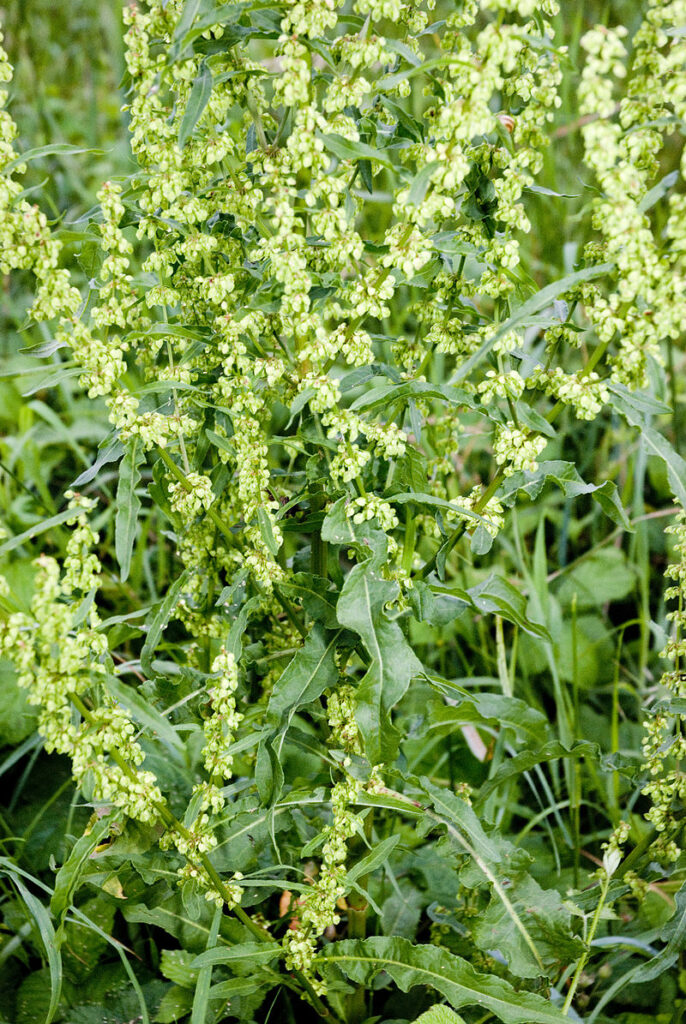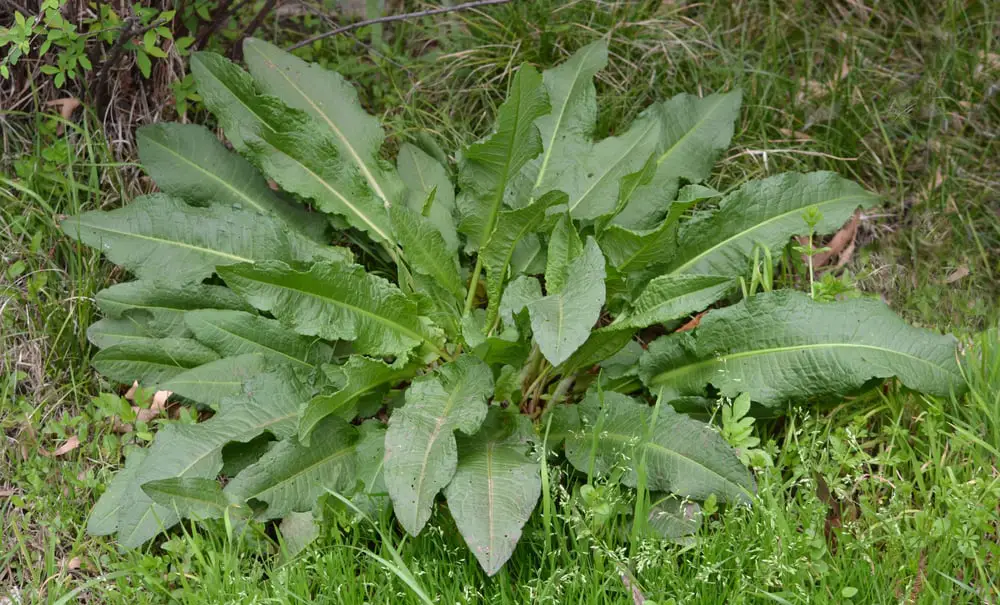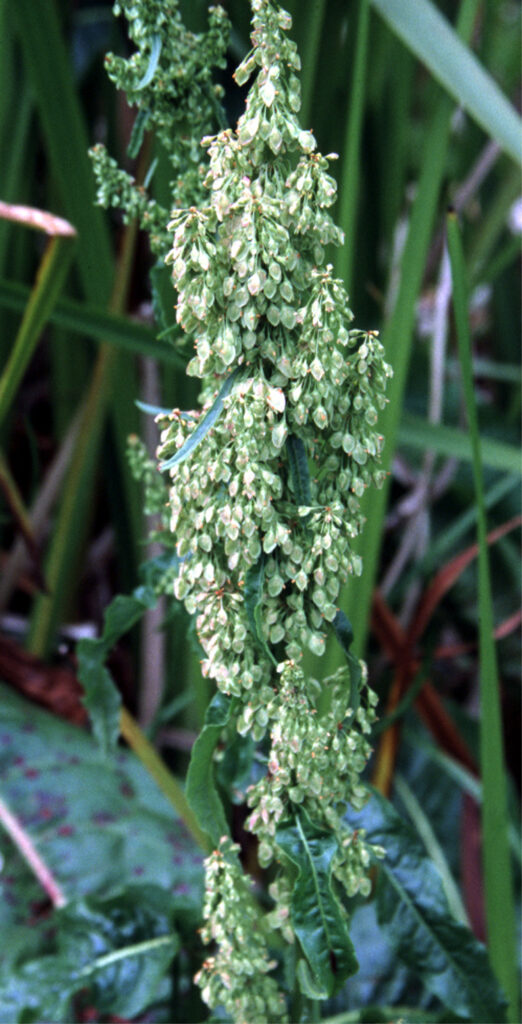Curly dock was popular as a great food source during the Great Depression due to its wide abundance, free availability , and its tart, lemony flavor. But now, when people spot a little curly dock growing in their yard, they usually assume it’s a weed and work to get rid of it. And truly, curly dock is a weed. It’s also just some green leaves popping up out of the ground, so it’s not particularly pretty. However, there’s more to these wild plants than first meets the eye, especially for the adventurous outdoor enthusiast.

Is Curly Dock Edible?
Curly dock is an edible plant. The curly dock leaves, flower stalk, and seeds are all edible. In fact, curly dock is highly nutritious. The plant is full of vitamin C, calcium, fiber, and antioxidants.
In times past, people would use the roasted seed of curly dock to make a coffee substitute. Today, people mostly eat the leaves.
The leaves of the curly dock are often compared to spinach. This may be helpful in thinking about how to eat curly dock leaves. If you were going to put spinach in it, you could replace curly dock leaves in that recipe. For example, people eat curly dock leaves in salads, soups, or stir-fries.
Due to high levels of oxalic acid, which gives the curly dock leaves a tart taste, these plants should be eatin in small quantities because they can irritate the urinary tract which increases the risk of developing kidney stones.
Note that the fully grown leaves of curly dock are different from their young leaves. Young leaves, which are very small, can sometimes cause your tongue to go numb. This is generally a good reason to avoid them. If your tongue goes numb while you’re eating, you could bite your tongue without noticing and really hurt yourself.

Curly Dock Leaves Look Different
As the name “curly dock” suggests, the leaves have curly edges. Sometimes they look more like waves than curls.
The dock plant starts close to the ground as a basal rosette. A flower stalk shoots up, with alternately growing leaves. The leaves themselves are green, broad, and don’t have a lot of ornate detail to them. Curly dock leaves can grow to be quite large, some get up to 12 inches long. While large, these are simple enough-looking leaves.
Curly dock leaves are attached to the main crown of the plant by leaf stems. When they’re young, the whole leaf will roll up and look more like a stem than a leaf, and they may feel slimy to the touch. These aren’t going to be the ones foragers want to find. They are looking for large, broad, unfurled leaves that hopefully haven’t been out in the sun for too long.
One distinct feature is that they do commonly develop rust-like blotches on them, particularly as the leaves age. This is a sign that the leaves are not going to taste good. They will be bitter, have a rough texture, and generally not be enjoyable.
Curly Dock Plants May Taste Different Depending On Where They’re Growing
Curly dock loves growing in the full sun. You can also find it in the partial shade. This perennial plant is oddly happy to grow in disturbed areas. This means you’ll see it at construction sites, playgrounds, parking lots, and growing along country roads. It might pop up in the middle of your gravel driveway.
However, curly dock growing in gravelly soil may not taste great. The stuff you find in the woods will have a richer flavor, something spinach combined with rhubarb. The curly dock growing in the gravel may have a rough, leather texture and an unpleasant flavor.
Also, note that wild plants growing in these types of disturbed areas may have been treated with pesticides or exposed to a lot of exhaust fumes. You do not want to eat plants that have spent their whole lives absorbing these types of chemicals. Instead, forage in places where you’re confident that the plants are truly wild and haven’t been treated with pesticides.
Since dock plants love moist areas and a fair amount of sun, you might look in open forests and alongside rivers and streams for the best curly dock.

Is There More Than One Kind Of Dock Plant?
Depending on where you are in the world, there are actually a few varied species that are commonly referred to as curly dock. The true curly dock carries the scientific name rumex crispus. It’s also known as yellow dock root. Rumex Crispus is native to western Asia and Europe. In the United States and Canada, it’s an invasive weed commonly known as curly dock or yellow dock.
Other varieties of curly dock include Rumex occidentalis and Rumex obtusifolius. R. occidentalis is more common on the west coast in North America, which is why it’s often referred to as western dock plant. R. obtusifolius grows in warmer climates around the world. It’s commonly called broad-leaved dock and bitter dock.
Every variety of dock plant seems to have its own common name. While some varieties are more regional, the Remux crispus (curly dock) is common across North America and Canada, and so it’s often the most well-known. While there are differences among the varieties, they also have a lot in common. At their core, they are edible plants, a common weed, and a member of the buckwheat family that loves to grow in moist soil.
When To Find Curly Dock
You can start looking for curly dock leaves in the early spring.
By the late spring and early summer, you’ll want to start looking for curly dock stems instead. If you’re going to eat, curly dock stems, you want to harvest them before the flower appears, as this is when they taste best. To tell if the stem is at its peak, gently bend the stem between your fingers. If it feels bendy, then it’s time to harvest. If it feels difficult to move, it’s probably too tough and not going to be fun or flavorful to eat. You can eat curly dock stems raw if they’re soft enough. You can also chop them up to put them in a salad. To cook them, you can saute them in a stir fry or steam them. You can use curly dock stems in any recipe you might use asparagus or green beans.
If you want to eat the yellow curly dock roots, you’ll want to wait until the plant has grown large enough for the roots to get to a good size. Usually, you can start harvesting the root as soon as the autumn of the plant’s first year. After that, if the ground is soft enough for you to dig the root out, you can forage for curly dock roots at any time, including winter or spring.
If you’re looking for curly dock seeds, you’ll want to wait until the seeds are brown. They should feel very thin and dry to the touch. You’ll first start seeing the seeds in the late summer, and they may still be around through the winter. While the seeds are edible, they are also a lot of work, so most people don’t give them much thought. Others enjoy harvesting the seeds and grinding the seeds and chaff up into flour.
Curly Dock Is A Weed With A Growing Fanbase
It may sound strange to say that a common weed has a following full of enthusiastic foragers, but it’s true. This plant is so easily overlooked that it’s a little exciting once people start noticing it and realizing how easy it is to forage and add to everyday meals. Once you learn to correctly identify curly dock, you’re likely to start noticing the wild plant everywhere you look. Soon enough, you’ll be working to come up with new ideas for adding the plant to your favorite recipes.
Recent Posts
The only venomous snakes in Washington State are Northern Pacific Rattlesnakes. The Northern Pacific Rattlesnake (Crotalus oreganus oreganus) is a sub-species of the Western Rattlesnake. Anyone...
Skunks are not classified as true hibernators. But they go into a state of torpor when the weather gets cold. Skunks are light sleep hibernators, along with opossums, bears, and raccoons. ...
